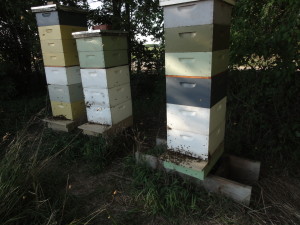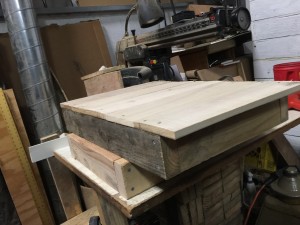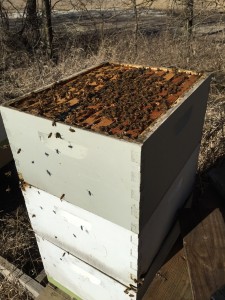 Wyandotte, Johnson, and Miami Counties, Kansas
Wyandotte, Johnson, and Miami Counties, Kansas
Fall 2013/Winter 2014 &
Fall 2014/Winter 2015
In 2013, I over-wintered each of my bee colonies in 3 deeps or 2 deeps and a medium honey super. I decided to do this earlier in the summer of 2013 as I had concerns about coming out of the hot, dry year we had just come through. Of course, when is it not a hot and dry year in Kansas?
I will post pictures and blog on the progress. So far, I’m grateful for not having the worry to need to look after for feed. All hives were treated organically for mites in July/August 2013 and populations looked great in October 2013. It’s standard in Minnesota and Wisconsin to practice over-wintering colonies in 3-deeps.
The honey bee survival issues are complex: weather, pesticides, nutrition, beekeeper practices, diseases, mites and other pests. The weather from year to year is not exact nor consistent. Rather than continue to worry about the volume of colony size going into fall/winter and amount of honey stores, I decided to treat for mites in a timely manner-at their peak population and let the colonies hive with additional resources of naturally stored honey and pollen, as well as space for a larger colony population.
Only time will tell me next early spring as winter losses are not really discernible until after the fact. The presence of mites is certainly a factor as a stressor. The survivors should come out with lots of bees, left over stores of honey and pollen so I won’t have to worry about checking for feed and stimulation. Colonies with large populations will be ready for splitting in early April when I should be able to get queen cell production in high gear.
2015 February
The results from last spring were that I did not have to worry about feeding the 3-deep overwintered colonies. Nearly 50% of my colonies were in 3-deeps for 2014/2015 Fall/Winter season as well. Generally speaking, the other 50% were over-wintered in 1-deep and 1-Western sized supers (7 & 5/8″), which I did have some concerns about those and I did feed at least 1 gallon 2:1 sugar syrup in November/December. I’m feed those again in early February 2015 for “peace of mind” as I’m sure they would not have made it in good shape as they had without being feed. I’m looking forward to splitting as many colonies in order to grow.
After over a decade, we are going back to solid bottom boards! Kenny Edmonds, Parkville, MO., is making solid bottom boards. The price is right and the wood is good! I am following Randy Oliver (Commercial Beekeeper, Biologist) in Northern California in that it’s going to be a process of phasing the screen bottoms out.

On a side note, it appears that I will be accepting 6-8 colonies for the Kansas Honey Producers’ Association state hives. The honey production from these colonies is used to supply our honey sales and promotion at the Kansas State Fair each September.


